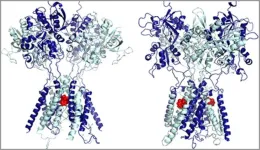(Press-News.org) Images
Climate change is a persistent and growing challenge to plant life on our planet. Changes to the environment that plants are unaccustomed to affect how they grow, putting much at risk. Increasingly, plant scientists are trying to determine how these environmental changes will impact plant life and whether plants will be able to acclimate to a new status quo.
Researchers from the Walker lab at the Michigan State University-U.S. Department of Energy Plant Research Laboratory, or PRL, are looking at how paper birch trees adapt to changing environments based on how they manage a vital plant process called photorespiration.
“If plant metabolism was a freeway system, photorespiration would be the second-highest trafficked road,” said Berkley Walker, associate professor in the Department of Plant Biology and at the PRL. “We are interested in understanding if the roads of this important pathway are large enough to handle all this traffic under present and future climate conditions.”
In humans, acclimation happens when we become accustomed to new conditions. We do this when we adjust to the cold weather of winter or while learning the ropes at a new job.
Plants must acclimate to new conditions as well. This is complicated by the fact that the increase of atmospheric carbon dioxide, or CO2, and global warming have the opposite effects on photosynthesis and photorespiration. When temperature increases, so does photorespiration, but when CO2 increases, photorespiration decreases. This tradeoff may alter the efficiency of photorespiration.
In a study published in Scientific Reports, researchers assessed whether paper birch trees adjust the activity of photorespiratory enzymes under different environmental conditions. Paper birch was selected because they live in boreal forest biomes, which are located in the northernmost parts of the planet and are expected to be among the ecosystems hit hardest by climate change.
The growth conditions were designed to mimic current, moderate and extreme climate change scenarios for the boreal forest regions, as simulated by the Intergovernmental Panel on Climate Change. In each of these scenarios, the researchers altered the CO2 concentration in the surrounding atmosphere and increased air temperatures in different combinations.
“This study explored whether plants fine-tuned their enzyme capacity based on demand or whether they keep a buffer, so they have extra capacity in reserve to handle unpredictable changes,” said Luke Gregory, former graduate student in the Walker lab and first author on the study.
Into the Biotron
Trees were grown from seeds by researchers from Professor Danielle Way’s lab at the University of Western Ontario. Way grew paper birch trees under six environmental conditions using the university’s Biotron, a research facility that can simulate nearly any climate on earth.
Way’s lab took measurements of the trees after four months of growth and sent leaf clippings to MSU. Gregory and his team looked at nine enzymes involved in the photorespiratory pathway in these leaves and their activities.
They found that the trees do not, in fact, increase their enzyme capacity depending on the climate they are grown in and instead maintained similar capacities across all six future climate scenarios. However, all the enzyme capacities measured in the study were more than was needed for the photorespiratory pathway — meaning the trees were prepared to grow, even under changing conditions.
“It was really interesting to find that there’s this safety factor that these plants have and it’s across all of these different environments that they’re able to have this buffer capacity,” Gregory said. “At first, we thought there was going to be this specific change to demand, but what we found is that across all of these different plants, they do maintain a buffer. They’re able to deal with these different changes whether under current, moderate or extreme conditions.”
This is good news: the trees have a built-in mechanism that will help them survive despite the changing climate, at least when it comes to photorespiration.
However, this is just one piece of the puzzle in understanding how photorespiration is and will continue to be affected by human-caused climate change.
“It’s important that we understand how plants are responding to current conditions and future conditions because we need them in our lives,” Gregory said. “Understanding if plants can acclimate or whether, over generations, they can adapt to these certain environments is important to understand because they provide a lot of fuel, food and fiber for us.”
By Kara Headley
###
Michigan State University has been advancing the common good with uncommon will for more than 165 years. One of the world’s leading public research universities, MSU pushes the boundaries of discovery to make a better, safer, healthier world for all while providing life-changing opportunities to a diverse and inclusive academic community through more than 400 programs of study in 17 degree-granting colleges.
For MSU news on the web, go to MSUToday or x.com/MSUnews.
END
MSU researchers find trees acclimate to changing temperatures
2024-11-19
ELSE PRESS RELEASES FROM THIS DATE:
World's first visual grading system developed to combat microplastic fashion pollution
2024-11-19
Over 14 million tonnes of microplastics are estimated to be lying on the ocean floor with the fashion industry among the worst pollutants.
But a new project led by textile experts at Heriot-Watt University in the Scottish Borders, is aiming to make fashion labels and consumers alike, more environmentally aware when manufacturing and buying new clothes.
For four years, a small team headed by Dr Lisa Macintyre, associate professor of textiles at the University’s School of Textiles and Design in the Galashiels campus, has overseen painstaking ...
Teenage truancy rates rise in English-speaking countries
2024-11-19
Working paper | Quantitative data analysis | People
Truancy rates have risen faster in developed English-speaking countries since the Covid-19 pandemic than in non-English-speaking countries, according to a new working paper by UCL researchers.
Teenage girls are also increasingly more likely to skip school than boys across Anglophone countries.
In 2022, 26% of all Year 11 pupils in England reported playing truant at least once in the last fortnight. This represented an increase from 2012 and 2018, the previous data capture points, when the figure was at 18% each time.
In the same year (2022), 29% of Year 11 girls in England reported skipping school in the past ...
Cholesterol is not the only lipid involved in trans fat-driven cardiovascular disease
2024-11-18
LA JOLLA (November 14, 2024)—Excess cholesterol is known to form artery-clogging plaques that can lead to stroke, arterial disease, heart attack, and more, making it the focus of many heart health campaigns. Fortunately, this attention to cholesterol has prompted the development of cholesterol-lowering drugs called statins and lifestyle interventions like dietary and exercise regimens. But what if there’s more to the picture than just cholesterol?
New research from Salk Institute scientists describes how another class of lipids, called sphingolipids, contributes to arterial plaques and atherosclerotic cardiovascular disease ...
Study: How can low-dose ketamine, a ‘lifesaving’ drug for major depression, alleviate symptoms within hours? UB research reveals how
2024-11-18
BUFFALO, N.Y. — University at Buffalo neuroscientists have identified the binding site of low-dose ketamine, providing critical insight into how the medication, often described as a wonder drug, alleviates symptoms of major depression in as little as a few hours with effects lasting for several days.
Published in September in Molecular Psychiatry, the UB discovery will also help scientists identify how depression originates in the brain, and will stimulate research into using ketamine and ketamine-like drugs for other ...
New nasal vaccine shows promise in curbing whooping cough spread
2024-11-18
As whooping cough cases rise in the U.S., a new nasal vaccine developed by Tulane University may hold the key to reducing the spread of the highly contagious respiratory disease.
Current pertussis vaccines are widely used and effective at preventing whooping cough, caused by the Bordetella pertussis bacteria. However, the vaccines fail to clear bacteria from the upper respiratory tract, allowing even vaccinated individuals to spread the disease.
The new vaccine combines the traditional pertussis antigens with an innovative ...
Smarter blood tests from MSU researchers deliver faster diagnoses, improved outcomes
2024-11-18
Image
Highlights:
MSU researchers now can identify more proteins, or biomarkers, in blood plasma, including those linked to specific diseases like cancer.
By identifying these biomarkers earlier, medical researchers can create better diagnostic tests and drugs that target diseases sooner, improving patient outcomes.
EAST LANSING, Mich. – Medical professionals have long known that the earlier a disease is detected, the higher the chance for a better patient outcome. Now, a multidisciplinary team of Michigan State University researchers, in ...
Q&A: A new medical AI model can help spot systemic disease by looking at a range of image types
2024-11-18
Artificial intelligence is making impressive strides in its ability to read medical images. In a recent test in Britain's National Health Service, an AI tool looked at the mammograms of over 10,000 women and correctly identified which patients were found to have cancer. The AI also caught 11 cases doctors had missed. But systemic diseases, such as lupus and diabetes, present a greater challenge for these systems, since diagnosis often involves many kinds of medical images, from MRIs to CT scans.
Sheng Wang, a University ...
For low-risk pregnancies, planned home births just as safe as birth center births, study shows
2024-11-18
CORVALLIS, Ore. – In low-risk pregnancies, mothers and children are just as safe with a planned home birth as they are with a planned birth center birth, a national study led by Oregon State University researchers has shown.
The findings, published in Medical Care, contradict doctors’ long-held concerns about home birth, including a recent opinion by the American College of Gynecologists and Obstetricians that describes hospitals and accredited birth centers as the safest places to have a baby. A birth center is a health care facility designed to provide a more natural and home-like environment than a hospital.
OSU ...
Leaner large language models could enable efficient local use on phones and laptops
2024-11-18
Large language models (LLMs) are increasingly automating tasks like translation, text classification and customer service. But tapping into an LLM’s power typically requires users to send their requests to a centralized server — a process that’s expensive, energy-intensive and often slow.
Now, researchers have introduced a technique for compressing an LLM’s reams of data, which could increase privacy, save energy and lower costs.
The new algorithm, developed by engineers at Princeton and Stanford Engineering, works by trimming redundancies and reducing the precision of an LLM’s ...
‘Map of Life’ team wins $2 million prize for innovative rainforest tracking
2024-11-18
Traditionally, taking inventory of the species in a rainforest requires sending in a team of experts with field guides and binoculars for a multi-day expedition. But the devastating pace of the destruction of the world’s rainforests and increasing urgency to better monitor and protect what remains demand faster, easier, and more efficient approaches.
Several years ago, a Yale-based team devised an alternate approach: they use lightweight, unmanned aerial vehicles (UAVs) to collect this critical biodiversity data in remote areas.
Now they’ve collected ...



